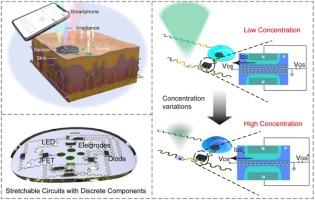无电池无线可拉伸可穿戴汗水传感器与离子驱动的光学信号转导和芯片级分立组件
IF 3.7
1区 化学
Q1 CHEMISTRY, ANALYTICAL
引用次数: 0
摘要
连续的可穿戴式汗液电解质监测可以为人体代谢动力学提供有价值的见解。现有的策略通常依赖于集成芯片和复杂的信号转导,这是耗电和限制可穿戴应用。在此,我们开发了一种无线和无电池的可拉伸传感器,用于同时检测汗液中的多种电解质。结合离子选择电极和结场效应晶体管(JFET),将汗液离子浓度变化引发的电极电位变化转化为JFET通道电流变化,并通过发光二极管(led)亮度变化读出该信号。该传感器具有高灵敏度和线性响应,K +在1 ~ 32 mM范围内,Na +在5 ~ 160 mM范围内,ph +在4 ~ 8 mM范围内。利用自行设计的快速图像处理算法,检测精度可与传统标准仪器相媲美,确保了可穿戴应用的实用性。值得注意的是,该传感器具有超低功耗,峰值功率仅为24.5~31.5 mW。通过集成微流控芯片和全弹性近场通信(NFC)电源天线,实现了全流程可穿戴检测策略。该传感器基于汗液电解质与人体健康的相关性,提供了一种高精度、超低功耗的现场检测平台,为家庭健康管理提供了一种解决方案。本文章由计算机程序翻译,如有差异,请以英文原文为准。

Battery-free wireless stretchable wearable sweat sensor with ion-driven optical signal transduction and chip-level discrete components
Continuous wearable monitoring of sweat electrolytes can provide valuable insights into human metabolic dynamics. Existing strategies usually rely on integrated chips and complicated signal transductions, which is power consuming and limits wearable applications. Herein, we developed a wireless and battery-free stretchable sensor for the detection of multiple electrolytes in sweat simultaneously. Ion-selective electrodes and junction field-effect transistors (JFETs) were integrated for the converting of electrode potential changes triggered by sweat ion concentration variations into JFET channel current changes, of which the signal could be read out through the brightness changes of light-emitting diodes (LEDs). This sensor exhibits high sensitivity and linear responses in the ranges of 1–32 mM for K⁺, 5–160 mM for Na⁺, and 4–8 for pH. Leveraging a self-designed fast image processing algorithm, the detection accuracy is comparable to that of traditional standard instruments, ensuring the practicality of wearable applications. Notably, the sensor is ultra-low-power consumption, with a peak power of only 24.5–31.5 mW. By integrating microfluidic chips and fully elastic near field communication (NFC) power supply antenna, the full-process wearable detection strategy is achieved. Based on the correlation between sweat electrolytes and human health, this sensor presents an on-site detection platform with high accuracy and ultra-low-power consumption, providing a solution for health management accessible to families.
求助全文
通过发布文献求助,成功后即可免费获取论文全文。
去求助
来源期刊

Sensors and Actuators B: Chemical
工程技术-电化学
CiteScore
14.60
自引率
11.90%
发文量
1776
审稿时长
3.2 months
期刊介绍:
Sensors & Actuators, B: Chemical is an international journal focused on the research and development of chemical transducers. It covers chemical sensors and biosensors, chemical actuators, and analytical microsystems. The journal is interdisciplinary, aiming to publish original works showcasing substantial advancements beyond the current state of the art in these fields, with practical applicability to solving meaningful analytical problems. Review articles are accepted by invitation from an Editor of the journal.
 求助内容:
求助内容: 应助结果提醒方式:
应助结果提醒方式:


